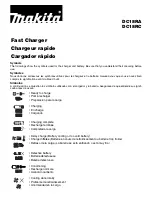
3
6.4 SLOT Selection.
This button is used to select desired slots for different working mode,
charge current or display mode. Press SLOT button will start the slots
selection processing in the sequence cycle of 1->2->3->4->4
slots->exit.
7.
Overheat Protection
When charger works at high current, there will be massive heat
generated inside the charger. To achieve a good charging result as
well as keeping batteries at the top condition, lowest temperature
rise is very important for both charger and battery. BT-C3000 charger
is equipped with a temperature controlled cooling system. When
internal temperature is lower than 40C, fan will be stopped. When
internal temperature or battery temperature is over 40C, fan will be
switched on.
With our improved charging circuit design, for normal good quality
battery with low impedance, heating built up on battery during
charging process is almost unnoticeable. However during the last
charging stage for Ni-Cd or Ni-Mh batteries, when battery is almost
full, batteries can become hot. This is normal: the larger charging
current applied, the more heat will build up. When battery
temperature is sensed to be over 60C, then over heat protection will
be kicked in for safety reason. When overheating occurs, current
working mode for all 4 slots will be automatically halted. To tell if it is
in the state of overheating protection mode, charging current will be
reduced to 0mA.
Charging/discharging process will only resume after battery
temperature drops below 40 degrees Celsius.
8.
Operation Modes and Display
8.1 Operation Modes:
Charge Mode: The rechargeable battery is charged up to its
maximum capacity. Accumulated charging capacity is
displayed at mAH display mode. For Ni-MH or Ni-Cd
batteries, after charging mode is completed, a trickle charge
current (around 10mA) will be applied. For Li-ion battery,
once charge mode is completed, no trickle charge current
will be applied. When Li-ion battery voltage is dropped less
than 4.0v, then charging will be activated until battery
voltage reaches 4.20v.
Discharge Mode: It is used to reduce the memory effect. The
rechargeable battery is discharged to a preset battery
voltage (0.9v for Ni-Cd & Ni-Mh, 2.8v for Li-ion batteries).
Once discharge is finished, total accumulated discharging
capacity is displayed at mAH display mode, showing how
much energy is discharged from the battery, which is always
referring to the accumulated discharging capacity. Trickle
charge current will be applied after discharge cycle is
finished, preventing the batteries from discharging any
further.
Refresh Mode: The rechargeable battery is charged and
discharged repeatedly to optimize to its maximum capacity.
Old rechargeable batteries or rechargeable batteries that
have not been used for a long period of time can be
restored to their rated capacity. Depends on the selected
charge current and battery impedance, it can take tens hours
or even days time before complete. Refresh mode will make
3 complete discharge-charge working cycles before
complete. After charge cycle is complete, the total charged
capacity will be displayed in mAH display mode even it is at
discharging stage of that cycle.
Test mode: Checks the present capacity of a rechargeable
battery. The maximum capacity is determined by discharging
the rechargeable battery after it was fully charged. If the
maximum capacity is much lower than the rated capacity
then it may reach the end of its lifetime.
Quick Test mode: The charger will analyze the dynamic
internal battery resistance by applying a load and the current
reading is referred to the voltage drop detected on the
battery. Within 10s, the tested battery resistance will be
displayed in the unit of milliohm. For good quality batteries,
the internal resistance is very low: in the range of 20 ~ 80
milliohms. If battery internal resistance is over 500milliohms,
then these batteries are not good for supplying power to
high current loads, such as digital camera etc. But they can
still be used for low energy loads, such as clock, remote
controllers etc. Always use batteries with close internal
resistance range when they are used in serial to achieve
maximum battery life. Alkaline and any other 1.5v batteries
can be tested on this charger as well. If a completely empty
battery is to be tested, it is not possible to give any correct
reading. Please be noted that since the internal battery
resistance can be very small, and contact resistance can be a
major influence factor, thus same battery tested in different
slot or even at the same slot with different contact condition,
the reading can be varied for 10% to 20%. This is normal.
Test twice if needed to assure a correct measurement result.






















